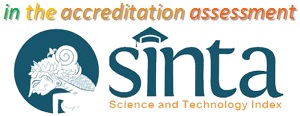Performance Comparison of Three Classification Algorithms for Non-alcoholic Fatty Liver Disease Patients Using Data Mining Tool
DOI:
https://doi.org/10.37034/medinftech.v1i1.2Keywords:
Performance, Comparison, Classification, Algorithms, LiverAbstract
This study aims to carry out a comparative analysis of the three classification algorithms used in research on Nonalcoholic Fatty Liver Disease (NAFLD) Patients. NAFLD is a liver condition associated with the accumulation of fat in the liver in individuals who do not consume excessive alcohol. The algorithms used in the analysis are Decision Tree, Naïve Bayes, and k-Nearest Neighbor (k-NN), with data processing using RapidMiner software. The data used is sourced from Kaggle which comes from the Rochester Epidemiology Project (REP) database with research conducted in Olmsted, Minnesota, United States. The measurement results show that the Decision Tree algorithm has an accuracy of 92.56%, a precision of 93.24%, and a recall of 99.08%. The Naïve Bayes algorithm has an accuracy of 89.93%, a precision of 95.40% and a recall of 93.56%. While the k-Nearest Neighbor algorithm has an accuracy of 91.33%, a precision of 91.94%, and a recall of 99.27%. ROC curve analysis, all algorithms show "Excellent" classification quality. However, only the k-NN algorithm reached 1.0, showing excellent classification results in solving the problem of classifying Nonalcoholic Fatty Liver Disease patients. This study concluded that the k-NN algorithm is a better choice in solving the problem of classifying Non-alcoholic Fatty Liver Disease patients compared to the Decision Tree and Naïve Bayes algorithms. This study provides valuable insights in the development of classification methods for the early diagnosis and management of NAFLD.
Downloads
References
AM Allen, TM Therneau, JJ Larson, A. Coward, VK Somers, and PS Kamath, “Nonalcoholic fatty liver disease incidence and impact on metabolic burden and death: A 20 year-community study,” Hepatology , vol . 67, no. 5, pp. 1726–1736, 2018, doi: 10.1002/hep.29546.
S. Pouwels et al. , “Non-alcoholic fatty liver disease (NAFLD): a review of pathophysiology, clinical management and effects of weight loss,” BMC Endocr. Disord. , vol. 22, no. 1, pp. 1–9, 2022, doi: 10.1186/s12902-022-00980-1.
S. Bashir, ZS Khan, F. Hassan Khan, A. Anjum, and K. Bashir, “Improving Heart Disease Prediction Using Feature Selection Approaches,” Proc. 2019 16th Int. Burban Conf. appl. sci. Technol. IBCAST 2019 , pp. 619–623, 2019, doi: 10.1109/IBCAST.2019.8667106.
M. Ghosh et al. , “A comparative analysis of machine learning algorithms to predict liver disease,” Intell. Autom. SoftComput. , vol. 30, no. 3, pp. 917–928, 2021, doi: 10.32604/iasc.2021.017989.
MBT and ASH Hartatik, “Prediction for Diagnosing Liver Disease in Patients using KNN and Naïve Bayes Algorithms,” 2020 2nd Int. Conf. Cyberne. Intell. syst. , pp. 1–5, 2020, doi: 10.1109/ICORIS50180.2020.9320797.
Z. Fadilah and Murnawan, "Performance Comparison of K-Nearest Neighbor and Decision Tree C4.5 by Utilizing Particle Swarm Optimization for Prediction of Liver Disease," Int. J. Open Inf. Technol. , vol. 9, no. 10, p. 9–15, 2021.
WFM and SL Muflikhah, N. Widodo, “Prediction of Liver Cancer Based on DNA Sequence Using Ensemble Method,” 2020 3rd Int. Monday. Res. inf. Technol. Intell. syst. , pp. 37–41, 2020, doi: 10.1109/ISRITI51436.2020.9315341.
SAD and SSSHS Obaid, “The Impact of Data PreProcessing Techniques and Dimensionality Reduction on the Accuracy of Machine Learning,” 2019 9th Annu. inf. Technol. Electromechanical Eng. Microelectron. Conf. , pp. 279–283, 2019, doi: 10.1109/IEMECONX.2019.8877011.
MA and MKHMF Rabbi, SM Mahedy Hasan, AI Champa, “Prediction of Liver Disorders using Machine Learning Algorithms: A Comparative Study,” 2020 2nd Int. Conf. Adv. inf. commun. Technol. , pp. 111–116, 2020, doi: 10.1109/ICAICT51780.2020.9333528.
IC Husin Muhamad, Cahyo Adi Prasojo , Nur Afifah Sugianto, Listiya Surtiningsih, "Optimization of Naïve Bayes Classifier Using Particle Swarm Optimization on Iris Data," J. Teknol. inf. and Computing Science. , vol. 4, no. 3, pp. 180–184, 2017, doi: 10.25126/jtiik.201743336.
and SKDMD Ganggayah, NA Taib, YC Har, P. Lio, "Predicting factors for survival of breast cancer patients using machine learning techniques," BMC Med. inform. Decis. Mac , vol. 19, n, p. 48, 2019, doi: 10.1186/s12911-019-0801- 4.
AP Wibawa et al. , “ Naïve Bayes Classifier for Journal Quartile Classification,” International Journal of Recent Contributions from Engineering, Science & IT (iJES) , vol. 7, no. 2.p. 91, 2019. doi: 10.3991/ijes.v7i2.10659.
R. Williams, T. Shongwe, AN Hasan, and V. Rameshar, “Heart Disease Prediction using Machine Learning Techniques,” 2021 Int. Conf. Anal Data. buses. ind. ICDABI 2021 , vol. 3075, no. 5, pp. 118–123, 2021, doi: 10.1109/ICDABI53623.2021.9655783.
S. Sakib, N. Yasmin, AK Tanzeem, F. Shorna, K. Md. Hasib, and SB Alam, “Breast Cancer Detection and Classification: A Comparative Analysis Using Machine Learning Algorithms,” Lect. Notes Electr. Eng. , vol. 844, no. March, pp. 703–717, 2022, doi: 10.1007/978-981-16-8862- 1_46.
Downloads
Published
How to Cite
Issue
Section
License
Copyright (c) 2023 Journal Medical Informatics Technology

This work is licensed under a Creative Commons Attribution-NonCommercial 4.0 International License.








